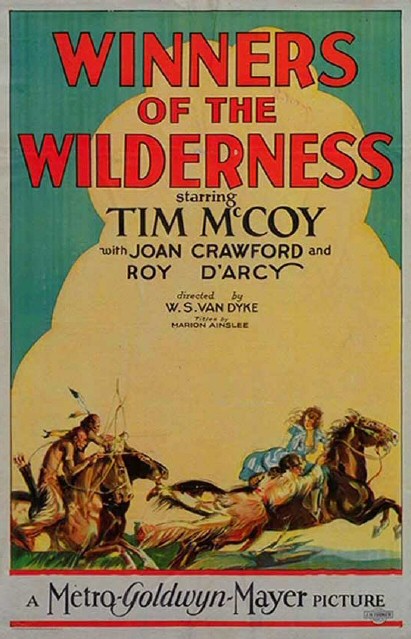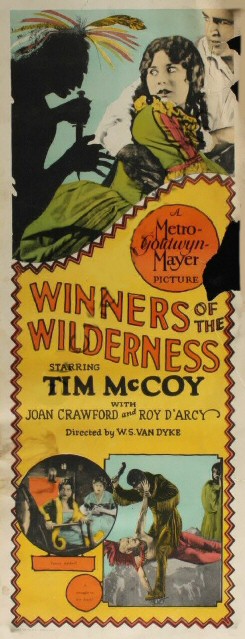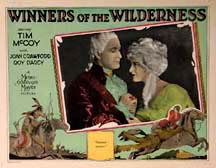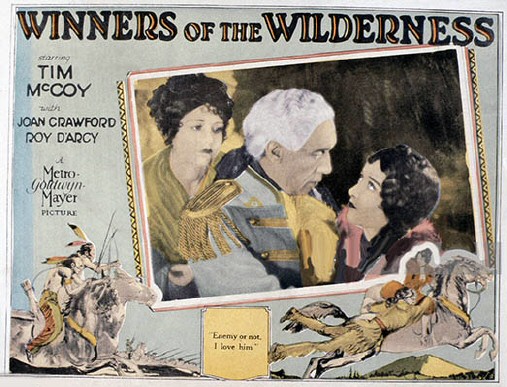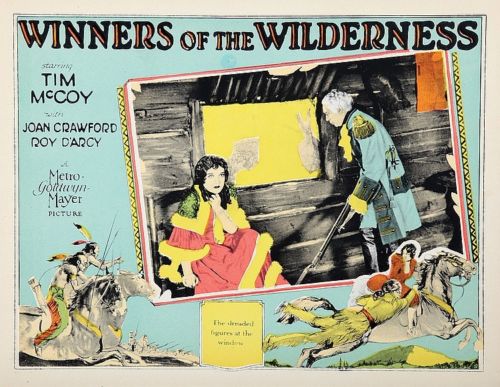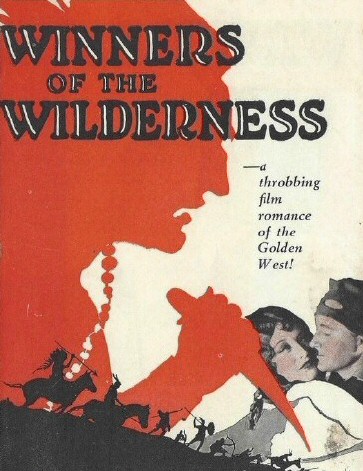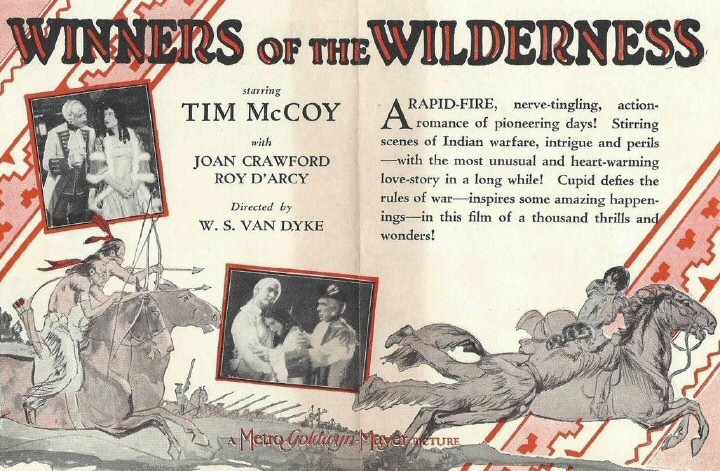|
 Tom C.
(July 2021) Tom C.
(July 2021)Rating:
  -1/2
of 5 -1/2
of 5
Winners
of the Wilderness is not a great movie. There, that’s out of the way!
But it stars a young Joan Crawford on the cusp of fame, and that makes it
worth hunting down a rare copy of this 1927 film, especially for Joan
aficionados.
Despite
being a middling costume drama, WOTW has some notable cast and crew.
The picture is directed by W.S. van Dyke--- One-Take Woody---who went on to
direct the Thin Man series, Tarzan, and many other films of note, and
who directed four JC films. This film stars Col. Tim McCoy, who enjoyed a
long career in Westerns in addition to serving his country in both WW1
and WW2; McCoy also co-starred with JC in the unavailable The Law of the
Range. McCoy is top-billed; he plays daring British agent Col. O'Hara.
The supporting cast includes Louise Lorraine, lady's maid to JC's
character. Ms. Lorraine, who like Joan was a WAMPAS "Baby Star" (1922
and 1926, respectively), is in the movie largely to inject some comedy
via her romance with Timothy, valet to Col. O'Hara. Timothy is played by
Tom O'Brien, who is noted for playing Bull in the MGM silent epic The
Big Parade. Others with significant roles are Edward Connelly, as the
commander of the French, General Contrecoeur. Roy D'Arcy plays Captain
Dumas. If you've seen any MGM film from this period, it will not
surprise you that D'Arcy plays a sneering baddie, and does so with great
aplomb.
Another
supporting player of note is Chief John Big Tree, head of the tribe
that is secretly in cahoots with the French in their attempt to wrest
the rich prize of America from the British. Native Americans are
generally shown in a good light, which, alas, is atypical of this era in
Hollywood films. Perhaps this is the influence of McCoy, who was a noted
expert on the Native Americans of the western U.S. and was greatly
respected by them, and vice versa.
Joan
is second-billed. She plays René Contrecoeur, daughter of the French
commander, and love interest to Col. O'Hara. Her first scene reveals
her to be no shrinking violet. Col. O'Hara---in his attempts to escape the
French, upon whom he has been spying---ends up in Joan's boudoir, his
identity concealed by a mask. He threatens her with a gun if she reveals
his presence. You know our Joanie is not to be cowed by such tactics!
Joan ignores his threats and alerts her father that the rapscallion is
in her room. A chase ensues and the masked O'Hara escapes.
What
follows is largely a showcase for Tim McCoy and the rugged image that
MGM seemed intent on developing for him. He wrestles Chief Big Tree; does lots of stunts on horseback; is involved in chases, battles,
fisticuffs, sword play, etc. Most importantly, McCoy wins the love of
René. In the end, national allegiances are forgotten in the face of true
love! After all, their children will be neither French nor British, but
Americans! Fade to black, happy ending!
This
being Hollywood, it is not a surprise that after their first impromptu
meeting, René's distaste for the British spy turns to love. After all,
who can resist 1920s ingenue Joan Crawford? To quote the good Colonel:
"T'would take a braver man that I to resist your lips!" You said it T
Mac! :)
Joan looks magnificent in her period costumes. I gather she didn't like
doing costume dramas, but I have enjoyed seeing her in the period
pieces I have watched (The Gorgeous Hussy comes to mind).
To
be honest, if WOTW were not an early Joan Crawford silent, I don't
think it'd be on many must-see lists. The available print is in poor
shape and the plot is formulaic. Joan's acting, however, insofar as one
can tell from the poor copy available, seems much improved over her 1925
and 1926 efforts. Indeed, I think after watching this movie that it's
not surprising JC made the transition from silents to talkies so easily.
Her acting is restrained when needed and she conveys emotion very well
with her gestures, facial expressions, etc. There is in her performance
only a modest amount of the overly melodramatic emoting that
characterizes many silent film actors. Oh, how I'd love to watch the
movies Joan made before and after WOTW---Paris, The Understanding Heart,
and The Taxi Dancer---to see that metamorphosis from chorus girl to
accomplished actress!
 Stephanie
Jones (October 2019) Stephanie
Jones (October 2019)
Rating:    of
5 of
5
I
grew up with the Films of Joan Crawford summary of this film,
which describes it in terms of the "admirable wilderness fighter"
Colonel O'Hara (Tim McCoy---billed as "Col. Tim McCoy,"
since he'd fought in WWI) battling Indians ("who constitute
an increasing menace to the white men") while romancing the
French general's daughter Renee Contrecouer (Joan), who is at some
point captured by said Indians.
After
finally seeing a print of the actual movie, though, it turns out
that the Indians are partly noble, the French are wicked, the British
are stupid, and the Colonials (represented by McCoy and General
George Washington himself) are the most noble of all! (And Joan's
Renee is never captured by Indians; they're on her father's French
side.) The overt social messaging that I find so annoying
today is, to me, sociologically fascinating when looking at a 1927 film!
The
68-minute silent film opens with titles explaining that 20 years
before the American Revolutionary War, the French and English are
fighting over North America. At this time, the Brits and Colonials
are allied against the French and Indians (led by Pontiac, chief
of the Six Nations). The first shot we see post-titles is of a masked
spy (Tim McCoy) peering in the window of a French Quebec mansion
where a treaty is being signed by French General Contrecouer (Joan's
father) and the Indians. McCoy bursts in and steals the papers and,
while being chased, takes refuge in the bedroom of the general's
daughter, Renee (Joan). We first see Joan as a bewigged reflection
in her mirror as she prepares for that evening's ball. When McCoy
demands her silence, she rebelliously, and flirtatiously, reveals
his presence (shades of similar scenes in "The Last of Mrs.
Cheyney" and "Strange Cargo").
As
McCoy is subsequently chased by French soldiers, Renee and her lady-in-waiting
Mimi (Louise Lorraine) look after him longingly, accompanied by
Mimi's funny title: "Oh
mistress -- what manners -- what daring, what wit -- what LEGS!"
(Mimi and her subsequent brief interactions with McCoy's aide-de-camp
Timothy provide the "common touch" humor of the film,
as in their exchanging of earthy sweet nothings such as "you
beautiful cabbage" interspersed during Renee and McCoy's more-genteely-romantic
interactions at the ball that follows).
After
McCoy's masked escape from Renee's bedroom, he reappears that evening,
unmasked, at the ball as an officially invited British officer,
Colonel O'Hara. Renee recognizes him but this time hides his identity
from her father and soldiers, although he is soon outed by the treacherous
French Captain Dumas (Roy D'Arcy) and has to again escape. As he
runs into the surrounding woods, he's attacked by an Indian who
turns out to be Chief Pontiac. The two tussle, with many somersaults,
and McCoy is finally the victor. Feeling mellow because he's in
love, McCoy grants mercy to Pontiac, asking the chief to remember
his kindness...
While
the first and last thirds of the film are devoted to such action/romance
shenanigans, the middle portion pauses for a nearly half-hour history
lesson about the battle of Fort Duquesne (in Pennsylvania). First,
we see McCoy back in Virginia meeting with British General Braddock
and a young George Washington, who, according to a title card wink-winking
to the audience, "has
the makings of a great soldier."
As it turns out, this Washington fellow has been warning Braddock
all along about the fighting power of the Indians. After some battle
scenes, a subsequent title card informs us: "So,
on the fateful July 9th, 1755 -- heedless of Washington's warnings
-- Braddock's proud command marched to its doom in the massacre
known to history as 'Braddock's Defeat' ----"
Another title reveals Braddock's last words: "We
will know better how to deal with them next time, boys."
During, and after, this battle interlude,
we get not-so-subtle inklings of what the filmmakers want us to
feel: The French, led by the smarmy D'Arcy, insist on a massacre
although their working-class French Canadian trapper allies chastise
them for it (throwing their fur caps down in disgust) and their
Indian allies, too, refuse to pursue the defeated. When the
evil D'Arcy presents the fallen Braddock's sword to Renee's father,
General Contrecouer, the latter somberly proclaims enemy Braddock
"a
brave soldier and a gallant gentleman." The Indians are also later
determined to be good guys. The earlier scrap between O'Hara and
Pontiac proves helpful because "Red
man never forget."
Post-battle, more machinations. And,
a final cut to the state of Virginia, with happy couple Renee and O'Hara emerging from a carriage.
Says one snobbish attendee: "She
is French -- you are British. What will the children be?"
Poor O'Hara looks confused until THE
George Washington whispers in his ear, and then O'Hara repeats:
"They
will be --- AMERICANS!"
Renee cutely wrinkles her nose at
the questioner as the happy couple departs. THE END.
Oh, yes, JOAN: Her early mildly defiant
bewigged scenes are good. Her various looks of longing are good.
Her final wrinkling of the nose is good. There's a horse chase,
and she's also good at hanging on there.
And the film is pretty
good, too. Some complicated history successfully sandwiched by stunts
and romance, plus overt pointers about what the dimwitted
viewer is supposed to take away about the good guys and bad guys
in US history.
 Shane Estes
(June 2011) Shane Estes
(June 2011)
Rating:
    of 5
of 5
I found
this film from a man in Pittsburgh who bought it on VHS 18 years ago and
transferred it to DVD for me. The fact that it exists at all is amazing. The
quality is rather poor. It is really bright in parts to the point where you
can’t see actual faces sometimes, and the sound is high pitched and squeaky,
but it’s all there. I actually expected it to be worse, so I was pleasantly
surprised. I would wager that the quality of some of these “lost silents” is
what keeps them from being released to DVD.
The
film is a period piece starring Tim McCoy and Joan Crawford in the first of two
collaborations between them. I was expecting it to have a “B-Western” kind of
feel to it, but that’s not what this is at all. There are many Western elements
in the film (guns, horses, Indians, etc.) but it is definitely not a Western.
The film looks like it actually had a pretty high budget. Apparently Tim McCoy
insisted that all the Native Americans portrayed in the film would be played by
actual Cherokee Indians, and they do look authentic to me. They definitely
aren’t white guys in make-up, which was very common for that time. A publicity
photo for the film showing Joan teaching the Cherokees how to do the Charleston
is pretty amusing, although Tim McCoy reputedly wasn’t too fond of it. I think
he was going for authenticity.
Winners has a comedic feel to it, with
Tim McCoy having a lot of charisma and humor that I was not expecting at all. He’s
kind of a swashbuckler in this role, very akin to a Douglas Fairbanks character.
He’s a lover, a soldier, a hero, a gentleman, and a rebel. It’s certainly not
all comedy though. There are many very serious moments in the film. One scene
in particular really caught me off guard. There is a moment in the film where
the Cherokees tie up a naked prisoner to a post and burn him at the stake while
riding around him on horses and slapping his buttocks with whips. I’ve seen
female nudity from time to time in films made before the Hays Code went into
full effect in 1934, but this is the first instance of male nudity that I have
seen.
Joan
Crawford plays the female lead in this film and is a major part of the plot
from beginning to end. Her role in Winners
is more significant than any other film she appeared in before this (that I
have seen). She’s not just a prop like she is in films like Tramp, Tramp, Tramp, and she’s not just
“the girl” like she is in films like The
Boob. Her character is integral to the progression of the story. She plays
the romantic interest of Tim McCoy and is the motivation for all of his actions
in the film, similar to the role she played in The Unknown. I really liked her in this. I’m usually not a big fan
of Joan in period pieces (like The Gorgeous Hussy), because she always comes
off as too modern to be believable, but she works really well in this for some
reason.
The
film’s setting is the French and Indians wars that took place in the middle of
the 18th century. Crawford plays a French society woman (Rene)
living in what is now Canada, and McCoy plays an English soldier (Colonel
O’Hara) from Virginia fighting on the side on the Indians. Of course he falls
in love with her, and it turns into a forbidden romance, somewhere along the
lines of Romeo and Juliet, but
without all the suicide. After much ado, they end up together by the end and
joke whether they should raise their children as French or English. “She is
French – you are British. What will the children be? They will be – AMERICANS!”
I was highly entertained by this
film. Crawford’s performance is flawless. It is definitely a fast-paced and
action-filled film from beginning to end. There’s never a dull moment! There’s
a really cute chase scene with Joan on a horse toward the end of the film that
is a must-see. The scene where the two meet each other on a balcony is quite
humorous as well. Joan says to McCoy, “In Quebec, the moon is usually in the
sky.” To which he replies,” That’s strange – the stars are in your eyes.” What’s up with lovers meeting on balconies in
these 1920s films? I enjoyed this film a lot and would recommend it to any fan
of Joan’s silent film performances.
|
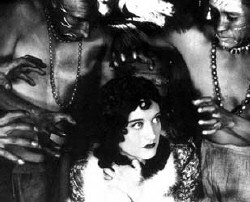 MGM
Silent. 68 minutes.
MGM
Silent. 68 minutes.



